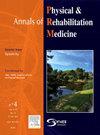普拉提减轻疼痛和残疾,提高生活质量的人与肌肉骨骼条件在四肢:一个系统的回顾
IF 4.6
3区 医学
Q1 REHABILITATION
Annals of Physical and Rehabilitation Medicine
Pub Date : 2025-04-22
DOI:10.1016/j.rehab.2025.101973
引用次数: 0
摘要
背景普拉提因其能减轻腰背痛患者的疼痛和残疾而广受欢迎。目的 调查普拉提对四肢肌肉骨骼疾病患者的疼痛、残疾、生活质量和身体功能的影响。方法 对使用普拉提治疗四肢肌肉骨骼疾病的实验研究进行系统回顾和荟萃分析。研究结果包括疼痛、残疾、生活质量和身体功能。我们检索了从开始到 2023 年 12 月的 11 个数据库。使用随机效应模型将证据综合为标准化平均差 (SMD) 和 95% 置信区间 (CI)。偏倚风险采用修订版 Cochrane 偏倚风险工具或 ROBINS-I 工具进行评估。GRADE 用于确定证据的确定性。研究存在中度至高度偏倚风险。与对照组相比,普拉提可减轻疼痛(5 项研究;SMD 1.41,95% CI,0.54-2.28)和残疾(5 项研究;SMD 0.83,95% CI,0.15-1.50),并提高生活质量(2 项研究;SMD 2.10,95% CI,0.34-3.86)。据估计,与对照组相比,普拉提对力量的影响较小(3 项研究;SMD 0.35),由于不确定性(95% CI,-0.27-0.98),真实效果尚不明确。由于缺乏数据,无法进行荟萃分析,因此普拉提对身体功能的其他方面(包括平衡、本体感觉和活动范围)的影响仍不清楚。结论与对照组相比,普拉提可减轻四肢肌肉骨骼疾病患者的疼痛和残疾,并提高其生活质量。然而,这一证据的确定性很低。普拉提对身体功能的影响仍不确定。支持普拉提优于其他运动干预措施的证据尚无定论。本文章由计算机程序翻译,如有差异,请以英文原文为准。
Pilates lessens pain and disability and improves quality of life in people with musculoskeletal conditions in the extremities: A systematic review
Background
Pilates has gained popularity for its benefits in reducing pain and disability among people with low back pain. However, conflicting evidence exists regarding its efficacy for musculoskeletal conditions in the upper and lower limbs.
Objectives
Investigate the effect of Pilates on pain, disability, quality of life, and physical function in people with musculoskeletal conditions in the extremities.
Methods
A systematic review and meta-analysis of experimental studies using Pilates for musculoskeletal conditions in the extremities. Our outcomes included pain, disability, quality of life, and physical function. We searched eleven databases from inception to December 2023. Evidence was synthesised as standardised mean differences (SMD) with 95% confidence intervals (CI) using random-effects models. Risk of bias was assessed using the Revised Cochrane risk of bias tool or the ROBINS-I tool. GRADE was used to determine evidence certainty.
Results
Eleven studies (n = 444) were included. Studies had moderate to high risk of bias. Pilates lessened pain (5 studies; SMD 1.41, 95% CI, 0.54–2.28), and disability (5 studies; SMD 0.83, 95% CI, 0.15–1.50), and improved quality of life (2 studies; SMD 2.10, 95% CI, 0.34–3.86) compared to the control group. The effect of Pilates on strength compared to the control the group was estimated to be small (3 studies; SMD 0.35), with unclear true effect due to uncertainty (95% CI, -0.27-0.98). The effects of Pilates on further aspects of physical function, including balance, proprioception, and range of motion remain unclear due to a lack of data which prevented meta-analysis.
Conclusion
Pilates was found to lessen pain and disability and improve quality of life in people with musculoskeletal conditions in the extremities compared to control. However, this evidence is of a very low certainty. The effect of Pilates on physical function remains uncertain. The evidence supporting the superiority of Pilates over other exercise interventions is inconclusive.
Review Registration
PROSPERO (CRD42022375925).
求助全文
通过发布文献求助,成功后即可免费获取论文全文。
去求助
来源期刊

Annals of Physical and Rehabilitation Medicine
Medicine-Rehabilitation
CiteScore
7.80
自引率
4.30%
发文量
136
审稿时长
34 days
期刊介绍:
Annals of Physical and Rehabilitation Medicine covers all areas of Rehabilitation and Physical Medicine; such as: methods of evaluation of motor, sensory, cognitive and visceral impairments; acute and chronic musculoskeletal disorders and pain; disabilities in adult and children ; processes of rehabilitation in orthopaedic, rhumatological, neurological, cardiovascular, pulmonary and urological diseases.
 求助内容:
求助内容: 应助结果提醒方式:
应助结果提醒方式:


